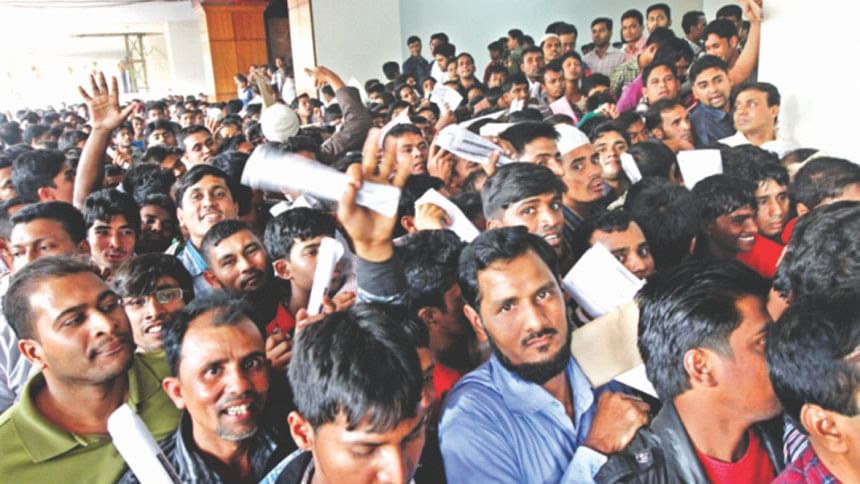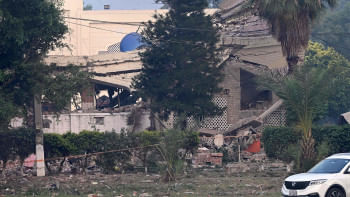The delusion of Bangladesh's cheap labour

In Bangladesh, the proportion of the population at or below working age is among the highest in the world and almost a third of the population is between ages 15-30. A young population means a young workforce full of innovation and productivity. However, youth unemployment in Bangladesh remains a festering wound to the economy -- the primary factors behind it being poverty, lack of education and skills.
Opportunities of reaping the benefits of a demographic dividend -- the potential economic boost due to a young population -- are slipping away as we speak because a considerable portion of our (young) population remains unskilled and uneducated. While the garment industry is considered the golden goose of our economy, we are failing to capitalise on the once-in-a-lifetime demographic dividend by not producing adequate high-skilled labour.
The mechanisms of our RMG sector, a prominent player in the country's economy, need to be highlighted to understand the link between the absence of a strong high-skilled workforce and a large pool of low-skilled workers glorified and categorised as "cheap labour". The RMG sector, owning the lion's share of export earnings, serves as a lens to explain why the nature of economic growth we're experiencing is not sustainable.
The sector itself is not the problem; the fact that we are stuck in low-end manufacturing within the RMG industry is the real hurdle. While our RMG sector imports all its capital machinery and almost all raw materials even though we have production capabilities of thread and fabric, we're left with the arduous task of knitting, stitching and assembling, i.e. manual labour.
While garment industrialists and their politician friends conceal the ills of low-skilled labour (and that includes child labour) by calling it "cheap labour" and "a rich source of foreign investment that will boost the economy," it must be pointed out that it is problematic to equate cheap labour with competitiveness. When are we going to free ourselves of this delusion? As if competitiveness equates to an equal distribution of wealth the industry is raking in and the development of high skills among our workers, which is what we actually need?
Are the skills of our country's young men and women forever going to be limited to menial tasks such as sewing, knitting, fishing, farming, selling tea, cleaning toilets, scrubbing floors and driving buses? Within no time, this demographic dividend may spell a demographic disaster with teeming multitudes of disillusioned, jobless men and women devoid of high skills needed to survive in an environment of cut-throat competition.
At a press conference in his Secretariat office, Commerce Minister Tofail Ahmed proclaimed that "the dream will come true with the signing of the MoU" between BGMEA and China's Orient International with regard to setting up of manufacturing units in the largest RMG industrial park to be established in Gazaria of Munshiganj district. This grand 'RMG city' will consist of around 300 to 500 plots for RMG units.
If I may ask, Honourable Minister, what exactly is this 'dream' you speak of and more importantly, whose dream is it? Given that our beloved RMG sector has given us wonderful memories to cherish like the Rana Plaza disaster and the Tazreen fire that have claimed thousands of "cheap" lives, can it be that the RMG city is what Bangladeshi workers have been "dreaming" of all these years?
While Bangladesh remains the second-largest RMG hub after China, neighbouring India and the Philippines are dominating the world rankings of information technology outsourcing (ITO) by yielding high-skilled employment. So how is it that Bangladesh and India, with so much in common, -- cultural, religious, and linguistic ties, demographic dividends and liberalisation policies -- have gone down such different paths in terms of high-skilled employment generation?
According to a survey conducted by Capgemini, the top three factors listed by executives in choosing an outsourcing destination are labour costs, technology/infrastructure capabilities, and skilled labour. Both India and the Philippines offer low cost IT solutions that boost both high-skilled and low-wage labour in the respective countries.
Bangalore has earned itself the sobriquet "The Silicon Valley of India" as a major global tech hub. The city consists of more than 35 percent of IT companies and is the largest IT contributor in the country. Chennai, Hyderabad, Delhi and Pune too are software development hotspots and house some of the biggest IT exporters in the country. The IT sector has transformed India's stature and enabled the country to form close ties with the US and the EU.
The growth of Bangalore's IT industry can be traced back to the 70s when the visionary R.K. Baliga, the brainchild of Silicon Valley, proposed building an 'electronic city'. The 'city' was eventually built in an industrial park in Bangalore with the help of the Indian government. Under an industrial policy declared in 1996 (shortly before the dotcom boom) consisting of incentives and concessions, hardware and software companies swooped in on the golden opportunity of these schemes and brought about a revolutionary change to India's economy.
India's secret weapon has been its young population which has been the main driver of technological growth. With a population of 430 million in 2011 in the age group 15-34, India has a huge young English-speaking pool which is expected to expand over the coming years. Foreign companies, global investment banks and businessmen are scrambling to get a piece of India's booming technology sector.
Back home in Bangladesh, a poor education system, weak R&D sector, lack of collaboration between universities and industries, absence of government agencies promoting growth of sectors geared towards generating high-skilled labour, lack of allocation of funds, institutional inefficiencies and a general substandard infrastructure are slowly killing an economy largely dependent on low-end manufacturing--cutting off any means of high skill development of the youth, especially those belonging to the lower and lower middle class.
What's worse is that we have become desensitised to the term "cheap labour" and too blinded to understand its underlying meaning. We are bombarded with optimistic headlines like "China to become one of Bangladesh's largest garments importers" and "Bangladesh, a hub for non-traditional garment products." But really, we have churned out a labour force of which the biggest comparative advantage is its cheapness due to its low skills.
Investment in human capital to promote high-skilled labour remains missing from MDG goals of Bangladesh, and that says a lot about the vision, or a lack thereof, of our future labour composition. Behind "success stories" of RMG and MDG is the failure to invest in our demographic dividend. Perhaps twenty or thirty years from now, when we will have lost our share in the RMG industry to some country with cheaper labour and with an aging population only equipped to knit sweaters, we'll regret not having read between the lines of the glorified "cheapness" and "competitiveness" of our labour.
The writer is a journalist at The Daily Star.

 For all latest news, follow The Daily Star's Google News channel.
For all latest news, follow The Daily Star's Google News channel. 



Comments